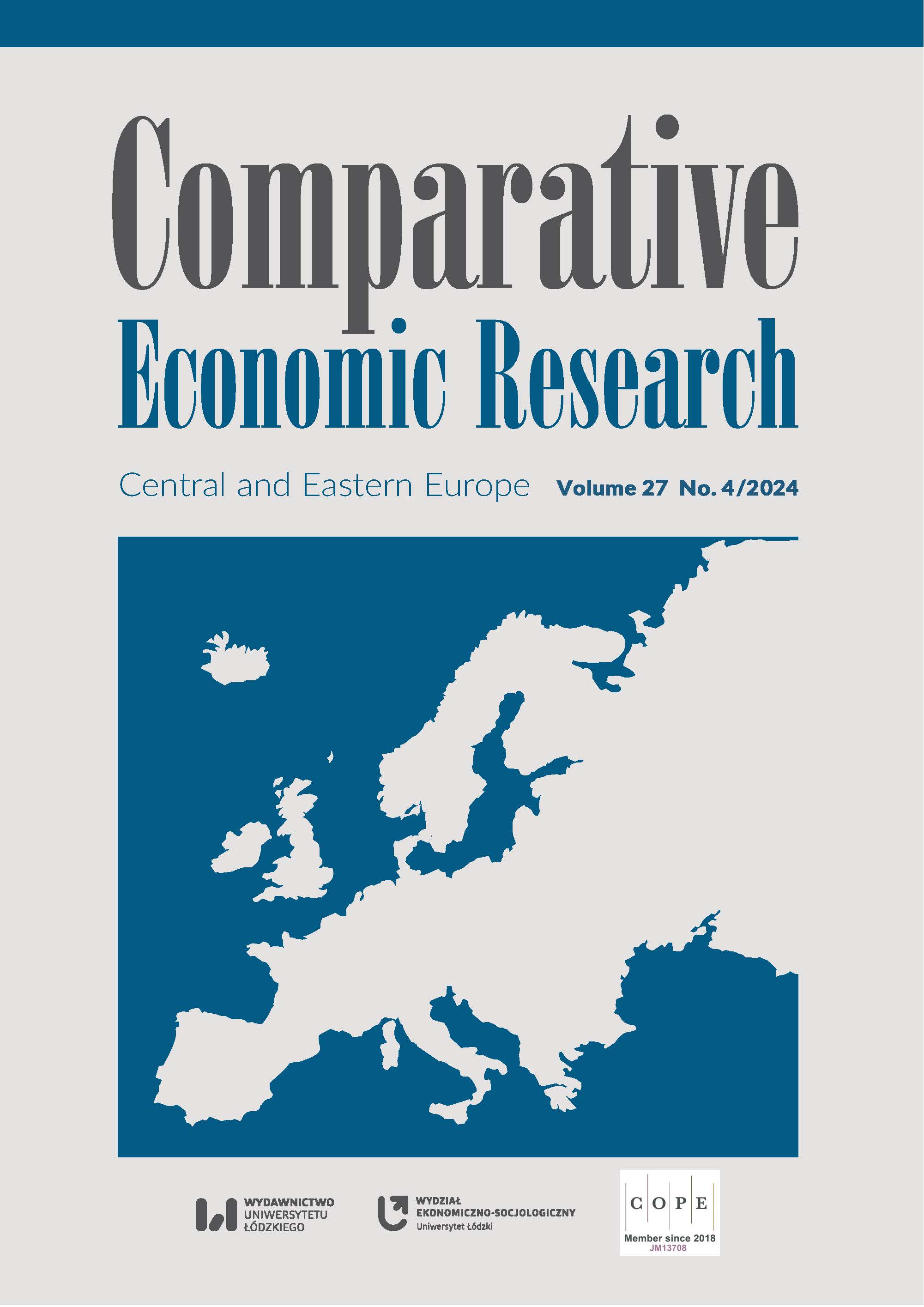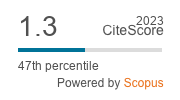Determinants of Industry 4.0 Readiness in the Manufacturing of the V4 Economies
DOI:
https://doi.org/10.18778/1508-2008.27.29Keywords:
Industry 4.0, Industry 4.0 readiness, Industry 4.0 transformation, manufacturing, Visegrad GroupAbstract
The article presents the results of research aimed at identifying the determinants of Industry 4.0 (I4.0) readiness in manufacturing and assessing the relevant progress made by the Visegrad Group (V4; i.e. the Czech Republic, Hungary, Poland and Slovakia) countries between 2011 and 2021.
The investigation relies on the authors’ proposal for twelve variables that constitute the basis for a study using principal component analysis (PCA). Based on the calculation of factor loadings, the study produces a composite indicator of I4.0 readiness. It is followed by an assessment of the V4 economies against the backdrop of the other EU Member States.
The V4 economies showed relatively low levels of I4.0 readiness and made no significant progress. The top performer was the Czech Republic, ranked 12th, on average, between 2011 and 2021. It was closely followed by Hungary (14th) and Slovakia (17th). Poland was ranked the lowest (20th).
The main contribution is the proposal of a set of determinants of I4.0 readiness in manufacturing.
Measuring the progress of I4.0 readiness in the V4 economies and identifying barriers to I4.0 implementation in manufacturing may have application value for public policies.
Downloads
References
Abdi, H., Williams, L.J., Valentin, D. (2013), Multiple factor analysis: principal component analysis for multitable and multiblock data sets, “Wiley Interdisciplinary Reviews: Computational Statistics”, 5 (2), pp. 149–179, https://doi.org/10.1002/wics.1246
Google Scholar
DOI: https://doi.org/10.1002/wics.1246
Aggarwal, A., Gupta, S., Ojha, M.K. (2019), Evaluation of Key Challenges to Industry 4.0 in Indian Context: A DEMATEL Approach, [in:] K. Shanker, R. Shankar, R. Sindhwani (eds.), Advances in Industrial and Production Engineering. Lecture Notes in Mechanical Engineering, Springer, Singapore, pp. 387–396, https://doi.org/10.1007/978-981-13-6412-9_37
Google Scholar
DOI: https://doi.org/10.1007/978-981-13-6412-9_37
Bakhtari, A.R., Kumar, V., Waris, M.M., Sanin, C., Szczerbicki, E. (2020), Industry 4.0 implementation challenges in manufacturing industries: An interpretive structural modelling approach, “Procedia Computer Science”, 176, pp. 2384–2393.
Google Scholar
DOI: https://doi.org/10.1016/j.procs.2020.09.306
Borys, T. (1980), Elementy teorii jakości, Państwowe Wydawnictwo Naukowe, Warszawa.
Google Scholar
Brettel, M., Friederichsen, N., Keller, M., Rosenberg, M. (2014), How virtualization, decentralization and network building change the manufacturing landscape: An Industry 4.0 Perspective, “International Journal of Information and Communication Engineering”, 8 (1), pp. 37–44.
Google Scholar
Chauhan, C., Singh, A., Luthra, S. (2021), Barriers to industry 4.0 adoption and its performance implications: An empirical investigation of emerging economy, “Journal of Cleaner Production”, 285, 124809, https://doi.org/10.1016/j.jclepro.2020.124809
Google Scholar
DOI: https://doi.org/10.1016/j.jclepro.2020.124809
Cugno, M., Castagnoli, R., Büchi, G. (2021), Openness to Industry 4.0 and performance: The impact of barriers and incentives, “Technological Forecasting and Social Change”, 168, 120756, https://doi.org/10.1016/j.techfore.2021.120756
Google Scholar
DOI: https://doi.org/10.1016/j.techfore.2021.120756
Da Silva, V.L., Kovaleski, J.L., Pagani, R.N., Silva, J.D.M., Corsi, A. (2020), Implementation of Industry 4.0 concept in companies: Empirical evidences, “International Journal of Computer Integrated Manufacturing”, 33 (4), pp. 325–342, https://doi.org/10.1080/0951192X.2019.1699258
Google Scholar
DOI: https://doi.org/10.1080/0951192X.2019.1699258
Ding, C., He, X.F. (2004), K‑Means Clustering via Principal Component Analysis, [in:] Proceedings of the 21st International Conference on Machine Learning, Association for Computing Machinery, New York, https://doi.org/10.1145/1015330.1015408
Google Scholar
DOI: https://doi.org/10.1145/1015330.1015408
Dou, Z., Wu, B., Sun, Y., Wang, T. (2021), The Competitiveness of Manufacturing and Its Driving Factors: A Case Study of G20 Participating Countries, “Sustainability”, 13 (3), 1143, https://doi.org/10.3390/su13031143
Google Scholar
DOI: https://doi.org/10.3390/su13031143
Drabińska, D. (2012), Innowacyjność gospodarki w wymiarze współczesnym i w ujęciu historycznym, “Kwartalnik Kolegium Ekonomiczno‑Społecznego. Studia i Prace”, 10 (2), pp. 9–25, https://doi.org/10.33119/KKESSiP.2012.2.1
Google Scholar
DOI: https://doi.org/10.33119/KKESSiP.2012.2.1
Eurostat (2023), Data Browser, https://ec.europa.eu/eurostat/databrowser/explore/all/all_themes?lang=en&display=list&sort=category (accessed: 15.05.2023).
Google Scholar
Fagerberg, J. (1987), A technology gap approach to why growth rates differ, “Research Policy”, 16 (2–4), pp. 87–99, https://doi.org/10.1016/0048-7333(87)90025-4
Google Scholar
DOI: https://doi.org/10.1016/0048-7333(87)90025-4
Frank, A.G., Dalenogare, L.S., Ayala, N.F. (2019), Industry 4.0 technologies: Implementation patterns in manufacturing companies, “International Journal of Production Economics”, 210, pp. 15–26, https://doi.org/10.1016/j.ijpe.2019.01.004
Google Scholar
DOI: https://doi.org/10.1016/j.ijpe.2019.01.004
Geissbauer, R., Schrauf, S., Koch, V. (2014), Industry 4.0: Opportunities and Challenges of Industrial Internet, PricewaterhouseCoopers, https://www.pwc.pl/pl/pdf/industry-4-0.pdf (accessed: 15.05.2023).
Google Scholar
Genest, M.C., Gamache, S. (2020), Prerequisites for the Implementation of Industry 4.0 in Manufacturing SMEs, “Procedia Manufacturing”, 51, pp. 1215–1220, https://doi.org/10.1016/j.promfg.2020.10.170
Google Scholar
DOI: https://doi.org/10.1016/j.promfg.2020.10.170
Govindan, K., Arampatzis, G. (2023), A framework to measure readiness and barriers for the implementation of Industry 4.0: A case approach, “Electronic Commerce Research and Applications”, 59, 101249, https://doi.org/10.1016/j.elerap.2023.101249
Google Scholar
DOI: https://doi.org/10.1016/j.elerap.2023.101249
Haddud, A., DeSouza, A., Khare, A., Lee, H. (2017), Examining potential benefits and challenges associated with the Internet of Things integration in supply chains, “Journal of Manufacturing Technology Management”, 28 (8), pp. 1055–1085, https://doi.org/10.1108/JMTM-05-2017-0094
Google Scholar
DOI: https://doi.org/10.1108/JMTM-05-2017-0094
Halse, L.L., Jæger, B. (2019), Operationalizing Industry 4.0: Understanding Barriers of Industry 4.0 and Circular Economy, [in:] F. Ameri, K. Stecke, G. von Cieminski, D. Kiritsis (eds.), Advances in Production Management Systems. Towards Smart Production Management Systems, APMS, “IFIP Advances in Information and Communication Technology”, 567, Springer, Cham, https://doi.org/10.1007/978-3-030-29996-5_16
Google Scholar
DOI: https://doi.org/10.1007/978-3-030-29996-5_16
Haverkort, B.R., Zimmermann, A., (2017), Smart Industry: How ICT will Change the Game?, “IEEE Internet Comput”, 21 (1), pp. 8–10, https://doi.org/10.1109/MIC.2017.22
Google Scholar
DOI: https://doi.org/10.1109/MIC.2017.22
Hermann, M., Pentek, T., Otto, B. (2016), Design Principles for Industrie 4.0 Scenarios, [in:] T.X. Biu, R.H. Sprague Jr. (eds.), Proceedings of the 49th Annual Hawaii International Conference on System Sciences HICSS 2016, IEEE Computer Society, Los Alamitos–Washington–Tokyo, pp. 3928–3937, https://doi.org/10.1109/HICSS.2016.488
Google Scholar
DOI: https://doi.org/10.1109/HICSS.2016.488
Horváth, D., Szabó, R. (2019), Driving forces and barriers of Industry 4.0: Do multinational and small and medium‑sized companies have equal opportunities?, “Technological Forecasting and Social Change”, 146, pp. 119–132, https://www.sciencedirect.com/science/article/pii/S0040162518315737 (accessed: 15.05.2023).
Google Scholar
DOI: https://doi.org/10.1016/j.techfore.2019.05.021
Hotelling, H. (1933), Analysis of a complex of statistical variables into principal components, “Journal of Educational Psychology”, 24 (6), pp. 417–441, https://doi.org/10.1037/h0071325
Google Scholar
DOI: https://doi.org/10.1037/h0071325
Huang, C.J., Talla Chicoma, E.D., Huang, Y.H. (2019), Evaluating the Factors that are Affecting the Implementation of Industry 4.0 Technologies in Manufacturing MSMEs, the Case of Peru, “Processes”, 7 (3), 161, https://doi.org/10.3390/pr7030161
Google Scholar
DOI: https://doi.org/10.3390/pr7030161
Hung, M. (2016), IoT Implementation and Management – from the Edge to the Cloud, https://gartner.com/en/doc/3873158‑iot‑implementation‑and‑management‑from‑the‑edge‑to‑the‑cloud‑a‑gartner‑trend‑insight‑report (accessed: 12.10.2023).
Google Scholar
Ingaldi, M., Ulewicz, R. (2019), Problems with the Implementation of Industry 4.0 in Enterprises from the SME Sector, “Sustainability”, 12 (1), 217, https://doi.org/10.3390/su12010217
Google Scholar
DOI: https://doi.org/10.3390/su12010217
Kamble, S.S., Gunasekaran, A., Sharma, R. (2018), Analysis of the driving and dependence power of barriers to adopt industry 4.0 in Indian manufacturing industry, “Computers in Industry”, 101, pp. 107–119, https://doi.org/10.1016/j.compind.2018.06.004
Google Scholar
DOI: https://doi.org/10.1016/j.compind.2018.06.004
Karadayi‑Usta, S. (2019), An Interpretive Structural Analysis for Industry 4.0 Adoption Challenges, “IEEE Transactions on Engineering Management”, 67 (3), pp. 973–978, https://doi.org/10.1109/TEM.2018.2890443
Google Scholar
DOI: https://doi.org/10.1109/TEM.2018.2890443
Kiel, D., Arnold, C., Voigt, K.I. (2017), The influence of the Industrial Internet of Things on business models of established manufacturing companies – A business level perspective, “Technovation”, 68, pp. 4–19, https://doi.org/10.1016/j.technovation.2017.09.003
Google Scholar
DOI: https://doi.org/10.1016/j.technovation.2017.09.003
Klingenberg, C.O., Borges, M.A., Antunes, A.J., (2022), Industry 4.0: What makes it a revolution? A historical framework to understand the phenomenon, “Technology in Society,” 70, 102009, https://doi.org/10.1016/j.techsoc.2022.102009
Google Scholar
DOI: https://doi.org/10.1016/j.techsoc.2022.102009
Kora, H., Beluli, R. (2022), Industrial Revolution 4.0 and its impact on the evolution of the firm’s organization and management, “Intercultural Communication”, 7 (1), pp. 115–125, https://doi.org/10.13166/ic/712022.4979
Google Scholar
DOI: https://doi.org/10.13166/ic/712022.4979
Kukuła, K. (2000), Metoda unitaryzacji zerowanej, Wydawnictwo Naukowe PWN, Warszawa.
Google Scholar
Kumar, R., Singh, R.K., Dwivedi, Y.K. (2020), Application of industry 4.0 technologies in SMEs for ethical and sustainable operations: Analysis of challenges, “Journal of Cleaner Production”, 275, 124063, https://doi.org/10.1016/j.jclepro.2020.124063
Google Scholar
DOI: https://doi.org/10.1016/j.jclepro.2020.124063
Lee, J., Bagheri, B., Kao, H.A. (2015), A Cyber‑Physical Systems architecture for Industry 4.0‑basedmanufacturing systems, “Manufacturing Letters”, 3, pp. 18–23, https://doi.org/10.1016/j.mfglet.2014.12.001
Google Scholar
DOI: https://doi.org/10.1016/j.mfglet.2014.12.001
Luthra, S., Mangla, S.K. (2018), Evaluating challenges to Industry 4.0 initiatives for supply chain sustainability in emerging economies, “Process Safety and Environmental Protection”, 117, pp. 168–179.
Google Scholar
DOI: https://doi.org/10.1016/j.psep.2018.04.018
Machado, C.G., Winroth, M., Carlsson, D., Almström, P., Centerholt, V., Hallin, M. (2019), Industry 4.0 readiness in manufacturing companies: challenges and enablers towards increased digitalization, “Procedia CIRP”, 81, pp. 1113–1118, https://doi.org/10.1016/j.procir.2019.03.262
Google Scholar
DOI: https://doi.org/10.1016/j.procir.2019.03.262
Masood, T., Sonntag, P. (2020), Industry 4.0: Adoption challenges and benefits for SMEs, “Computers in Industry”, 121, 103261, https://doi.org/10.1016/j.compind.2020.103261
Google Scholar
DOI: https://doi.org/10.1016/j.compind.2020.103261
Müller, J.M., Buliga, O., Voigt, K.I. (2018), Fortune favors the prepared: How SMEs approach business model innovations in Industry 4.0, “Technological Forecasting and Social Change”, 132, pp. 2–17, https://doi.org/10.1016/j.techfore.2017.12.019
Google Scholar
DOI: https://doi.org/10.1016/j.techfore.2017.12.019
Narwane, V.S., Raut, R.D., Yadav, V.S., Singh, A.R. (2021), Barriers in sustainable industry 4.0: a case study of the footwear industry, “International Journal of Sustainable Engineering”, 14 (3), pp. 175–189, https://doi.org/10.1080/19397038.2020.1836065
Google Scholar
DOI: https://doi.org/10.1080/19397038.2020.1836065
Nhamo, G., Nhemachena, C., Nhamo, S. (2020), Using ICT indicators to measure readiness of countries to implement Industry 4.0 and the SDGs, “Environmental Economics and Policy Studies”, 22 (2), pp. 315–337, https://doi.org/10.1007/s10018-019-00259-1
Google Scholar
DOI: https://doi.org/10.1007/s10018-019-00259-1
OECD (2024), https://stats.oecd.org/Index.aspx?DataSetCode=TIVA_2022_C1# (accesed: 5.01.2024).
Google Scholar
Ojra, A. (2019), Revisiting Industry 4.0: A New Definition, [in:] K. Arai, S. Kapoor, R. Bhatia (eds.), Intelligent Computing. Proceedings of the 2018 Computing Conference, Vol. 1, Springer, Cham, pp. 1156–1162, https://doi.org/10.1007/978-3-030-01174-1_88
Google Scholar
DOI: https://doi.org/10.1007/978-3-030-01174-1_88
Pearson, K. (1901), LIII. On lines and planes of closest fit to systems of points in space, “The London, Edinburgh, and Dublin Philosophical Magazine and Journal of Science”, 2 (11), pp. 559–572, https://doi.org/10.1080/14786440109462720
Google Scholar
DOI: https://doi.org/10.1080/14786440109462720
Prause, G. (2015), Sustainable Business Models and Structures for Industry 4.0, “Journal of Security and Sustainability”, 5 (2), pp. 159–169.
Google Scholar
DOI: https://doi.org/10.9770/jssi.2015.5.2(3)
Raj, A., Dwivedi, G., Sharma, A., Sousa Jabbour, A.B.L. de, Rajak, S. (2020), Barriers to the adoption of industry 4.0 technologies in the manufacturing sector: An inter‑country comparative perspective, “International Journal of Production Economics”, 224, 107546, https://doi.org/10.1016/j.ijpe.2019.107546
Google Scholar
DOI: https://doi.org/10.1016/j.ijpe.2019.107546
Rupp, M., Schneckenburger, M., Merkel, M., Börret, R., Harrison, D.K. (2021), Industry 4.0: A Technological‑Oriented Definition Based on Bibliometric Analysis and Literature Review, “Journal of Open Innovation: Technology, Market, and Complexity”, 7 (1), 68, https://doi.org/10.3390/joitmc7010068
Google Scholar
DOI: https://doi.org/10.3390/joitmc7010068
Sagan, A. (2004), Jeden obraz ukazuje więcej niż 10 liczb, czyli jak budować mapy zadowolenia klienta z wykorzystaniem programu STATISTICA, http://media.statsoft.nazwa.pl/_old_dnn/downloads/04obraz.pdf (accessed: 9.03.2023).
Google Scholar
Savage, G. (2022), Breaking down the barriers to Industry 4.0 in the north, Australian Strategic Policy Institute, Barton, https://ad‑aspi.s3.ap‑southeast-2.amazonaws.com/2022-08/SR188%20Breaking%20down%20the%20barriers_0.pdf (accessed: 10.02.2024).
Google Scholar
Sayem, A., Biswas, P.K., Khan, M.M.A., Romoli, L., Dalle Mura, M. (2022), Critical Barriers to Industry 4.0 Adoption in Manufacturing Organizations and Their Mitigation Strategies, “Journal of Manufacturing and Materials Processing”, 6 (6), 136, https://doi.org/10.3390/jmmp6060136
Google Scholar
DOI: https://doi.org/10.3390/jmmp6060136
Schröder, C. (2016), The challenges of industry 4.0 for small and medium‑sized enterprises, Friedrich‑Ebert‑Stiftung, Bonn.
Google Scholar
Siuta‑Tokarska, B. (2017), Zaawansowanie technologiczne przedsiębiorstw sektora MŚP w Polsce, “Nierówności Społeczne a Wzrost Gospodarczy”, 50 (2), pp. 241–255, https://doi.org/10.15584/nsawg.2017.2.15
Google Scholar
DOI: https://doi.org/10.15584/nsawg.2017.2.15
Sousa Jabbour, A.B.L. de, Jabbour, C.J.C., Foropon, C., Godinho Filho, M. (2018), When titans meet – Can industry 4.0 revolutionise the environmentally‑sustainable manufacturing wave? The role of critical success factors, “Technological Forecasting and Social Change”, 132 (C), pp. 18–25, https://doi.org/10.1016/j.techfore.2018.01.017
Google Scholar
DOI: https://doi.org/10.1016/j.techfore.2018.01.017
Sztemberg‑Lewandowska, M. (2017), Analiza niezależnych głównych składowych, “Prace Naukowe Uniwersytetu Ekonomicznego We Wrocławiu”, 468, pp. 222–229, https://doi.org/10.15611/pn.2017.468.23
Google Scholar
DOI: https://doi.org/10.15611/pn.2017.468.23
UN (2023), Global indicator framework for the Sustainable Development Goals and targets of the 2030 Agenda for Sustainable Development, https://unstats.un.org/sdgs/indicators/Global%20Indicator%20Framework%20after%202022%20refinement_Eng.pdf (accessed: 29.03.2023).
Google Scholar
UNIDO (2023), Competitive Industrial Performance Index (CIP), https://stat.unido.org/cip/ (accessed: 15.05.2023).
Google Scholar
UNIDO (2024), UNIDO Statistics Data Portal, https://stat.unido.org/analytical‑tools/sdg?tab=charts&country=616 (accesed: 5.01.2024).
Google Scholar
Wang, S., Wan, J., Zhang, D., Li, D., Zhang, C. (2016), Towards smart factory for industry 4.0: a self‑organized multi‑agent system with big data‑based feedback and coordination, “Computer Networks”, 101, pp. 158–168, https://doi.org/10.1016/j.comnet.2015.12.017
Google Scholar
DOI: https://doi.org/10.1016/j.comnet.2015.12.017
Wnorowski, H.J. (2011), Instytucjonalne uwarunkowania działalności przedsiębiorstw w krajach Unii Europejskiej, Wydawnictwo Uniwersytetu w Białymstoku, Białystok.
Google Scholar
Wodnicka, M. (2021), Wpływ czwartej rewolucji przemysłowej na innowacyjność usług, “Optimum Economic Studies”, 3 (105), pp. 48–59, https://doi.org/10.15290/oes.2021.03.105.04
Google Scholar
DOI: https://doi.org/10.15290/oes.2021.03.105.04
Downloads
Published
How to Cite
Issue
Section
License

This work is licensed under a Creative Commons Attribution-NonCommercial-NoDerivatives 4.0 International License.
Funding data
-
Uniwersytet Ekonomiczny w Krakowie
Grant numbers 075/EEG/2022/POT











